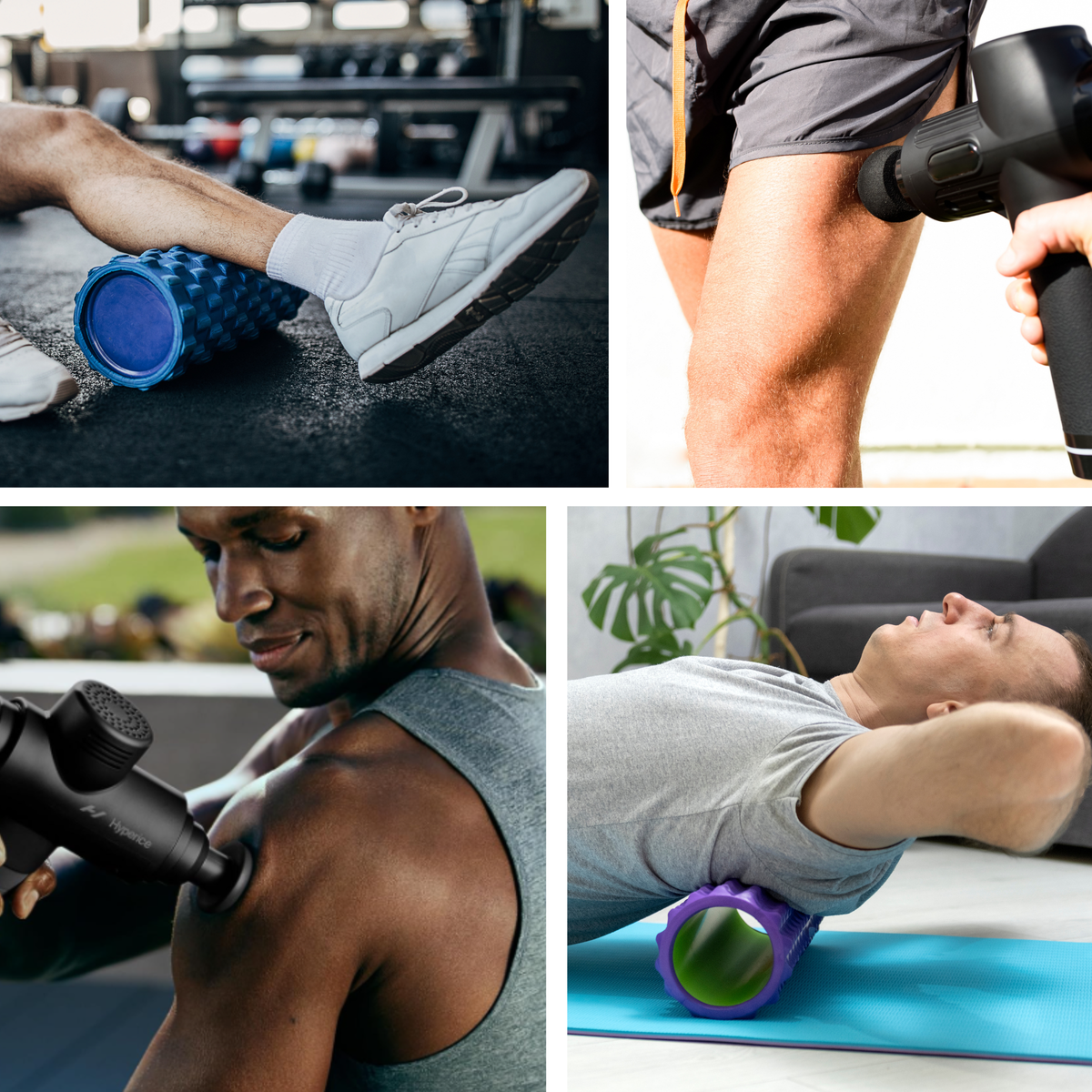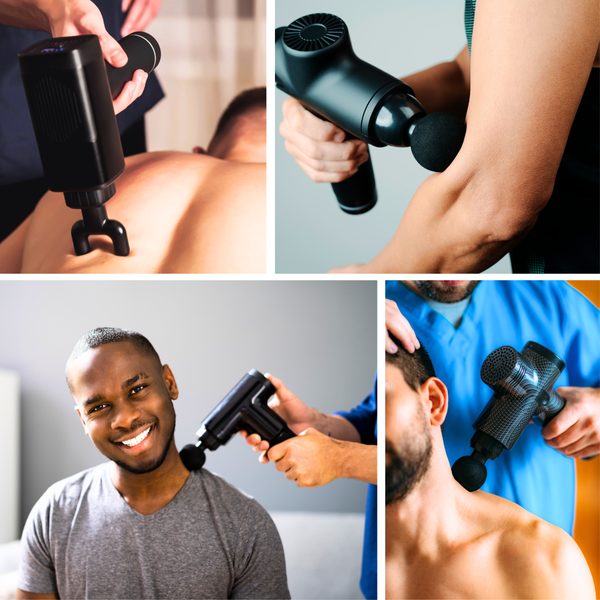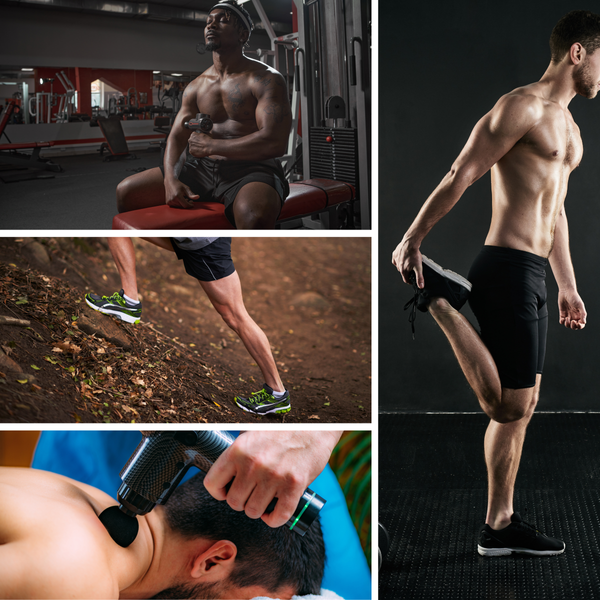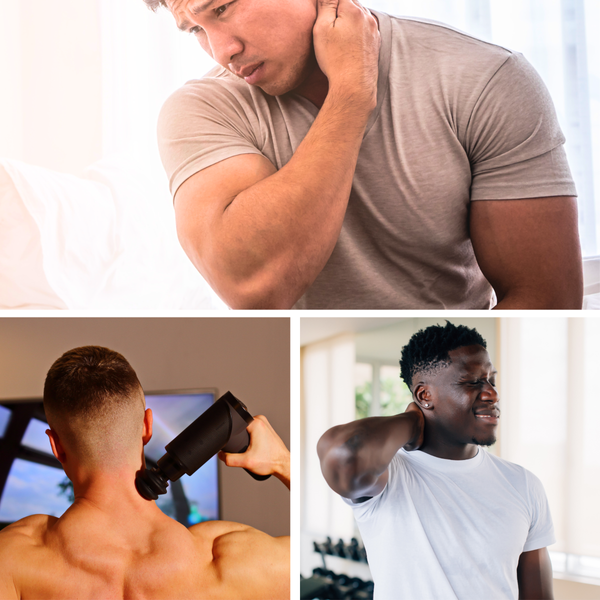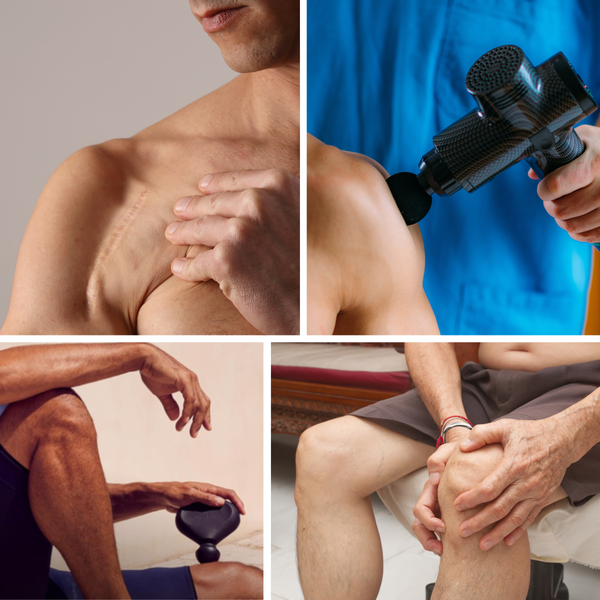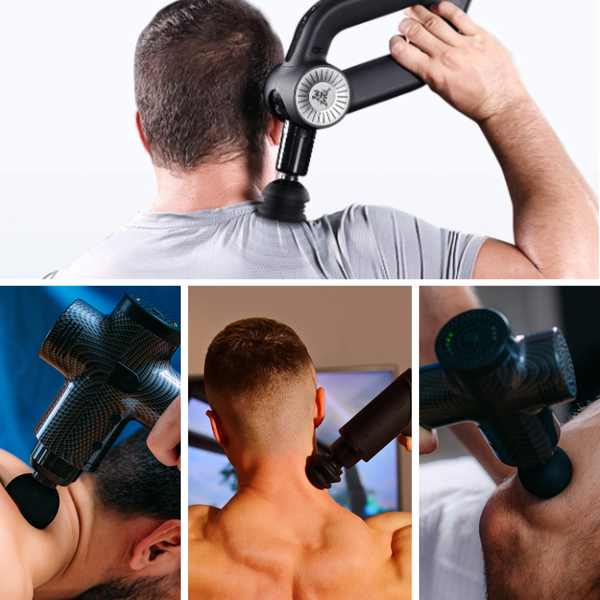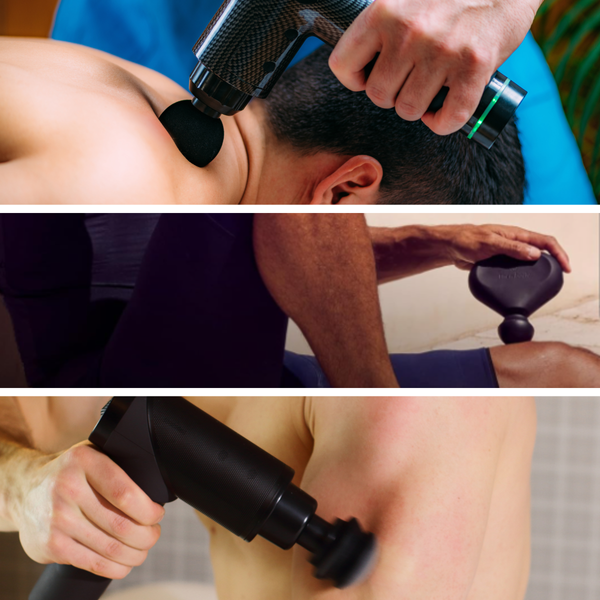Key Takeaways:
- Understand the distinct functions of massage guns and foam rollers in muscle recovery.
- Learn about the benefits and limitations of each tool for specific recovery needs.
- Discover which tool might be more effective for your personal fitness routine.
Introduction to Muscle Recovery Tools
In the realm of fitness and recovery, two tools have gained significant attention for their ability to alleviate muscle soreness and enhance recovery: massage guns and foam rollers. Both have their advocates and can be found in gyms, physical therapy clinics, and homes worldwide. But when it comes to reducing muscle pain and improving recovery times, many ask: is a massage gun better than a foam roller?
Understanding Massage Guns and Foam Rollers
Massage guns rely on percussive therapy to deliver deep tissue massage, targeting specific body areas with rapid, repetitive strokes. This form of vibration massage aims to increase blood flow, reduce muscle soreness, and aid in recovery. Foam rollers, on the other hand, offer a form of self-massage or myofascial release by using body weight to apply pressure to tight muscles, aiming to alleviate muscle soreness and improve range of motion.

The Science Behind Muscle Recovery
Muscle recovery is a critical aspect of any training session. Delayed onset muscle soreness (DOMS) can hinder performance and prolong recovery time. Both massage therapy and self-massage techniques like foam rolling pre-workout or post-exercise have been shown to help reduce inflammation and onset muscle soreness DOMS.
Massage Therapy vs. Self Massage
Massage therapists have used soft tissue manipulation for over a decade to help reduce soreness and aid in injury prevention. Self-massage tools like foam rollers and massage guns bring some of these huge benefits into the hands of athletes and fitness enthusiasts, allowing for more frequent and convenient treatment.
Benefits of Massage Guns
Massage guns offer targeted, deep tissue manipulation that can reach harder to reach areas like tight hamstrings. The increased range and deeper pressure provided by a percussion massager can be particularly effective for larger muscle groups and for reducing DOMS after an intense workout.
Percussive Therapy and Muscle Tension
Percussive therapy delivered by massage guns is designed to work on muscle tissue at a deeper level. This can lead to a more immediate sense of pain relief and can be particularly beneficial for sports massage, where specific areas require attention.
Foam Rollers and Muscle Health
Foam rolling pre-workout can prepare the muscles for exercise by increasing blood flow and range of motion. Post-workout, foam rollers can help reduce muscle soreness through myofascial release, which helps to break up knots and improve blood circulation.

The Role of Foam Rolling in Recovery
Regular use of foam rollers can contribute to long-term muscle health and flexibility. By using one's own body weight to roll over various muscle groups, foam rollers provide a more generalized pressure that can benefit the overall soft tissue.
Comparing Effectiveness for Pain Relief
When it comes to pain relief, both tools have their merits. Massage guns can provide immediate relief by desensitizing pain receptors, while foam rollers offer a more gradual approach to reducing muscle pain through sustained pressure and movement.
Impact on Blood Circulation
Both rollers and massage guns can increase blood flow to specific areas, which is crucial for recovery and reducing inflammation. However, the vibration therapy from massage guns may stimulate circulation more intensely than the steady pressure from foam rolling.
Personal Experience and User Preferences
When considering the debate of foam roller vs massage gun, personal experience plays a pivotal role. Some individuals find the manual pressure of a foam roller to be more soothing and effective, especially when it comes to foam rolling pre workout routines. The ability to control the pressure and pace can make foam rolling a meditative and personalized experience. On the other hand, massage guns offer a more hands-off approach, which can be a boon for those with limited mobility or strength to perform manual rolling.
The choice between these tools often comes down to user preference. While a massage gun can deliver a consistent level of percussive therapy, a foam roller allows for a varied approach, depending on how one uses it. For instance, slowly rolling over a muscle group with a foam roller can provide a deep stretch and release, whereas quick, short rolls can stimulate the muscle and prepare it for warm ups. The versatility of a foam roller in this regard is a significant factor for many fitness enthusiasts.

The Role of Warm-Up in Injury Prevention
When it comes to preventing injuries during exercise, a proper warm-up is as crucial as the workout itself. Warming up gradually revs up your cardiovascular system, increases blood flow to your muscles, and raises your body temperature, which can reduce the risk of strains and sprains. Massage guns can play a pivotal role in this phase by quickly loosening up the muscles and preparing them for physical activity. Their targeted vibrations stimulate blood flow, making them an excellent tool for a dynamic warm-up routine.
Foam rollers, on the other hand, offer a more controlled approach to warming up. By using your body weight to apply pressure, foam rolling can help in releasing muscle tightness and improving range of motion before you dive into more strenuous activities. This myofascial release technique is particularly beneficial for addressing areas that are typically tense and are prone to injury during workouts. Incorporating foam rolling into your warm-up routine can lead to a more effective and safer exercise session.
Enhancing Warm-Up Routines with Recovery Tools
Integrating massage guns and foam rollers into warm-up routines can significantly enhance their effectiveness. A massage gun can be used to quickly wake up the muscles, especially for those who have limited time for warm-ups. Its percussive therapy can activate the nervous system, preparing the muscles for immediate, high-intensity action. This is particularly useful for athletes who require a rapid transition from rest to high-level performance, such as sprinters or weightlifters.
Foam rollers, while slower in application, provide a deep-tissue massage effect that can be very beneficial during warm-ups. By rolling over various muscle groups, individuals can work on increasing their flexibility and range of motion. This not only helps in preventing injuries but also ensures that the muscles are well-prepped and capable of performing at their best. For example, runners may focus on rolling their calves and hamstrings to prevent common running-related injuries, while a yoga practitioner might target the back and shoulders to deepen their practice.

Combining Tools for Optimal Results
In the discussion of massage gun vs foam roller, it's worth considering that these tools need not be mutually exclusive. In fact, combining the use of both can lead to optimal muscle recovery and preparation. A massage gun can be used for targeting specific knots and areas of intense muscle tightness, providing rapid, percussive relief. This can be particularly beneficial post-workout when muscles are fatigued and in need of quick recovery.
Conversely, a foam roller is excellent for a more comprehensive approach, covering larger muscle groups and promoting flexibility. Foam rolling pre workout can increase blood flow and help in the warm-up process, reducing the risk of injury. Post-exercise, it can aid in flushing out lactic acid and reducing soreness. By integrating both a massage gun and a foam roller into one's fitness regimen, individuals can enjoy the unique benefits each tool offers, potentially enhancing their overall performance and well-being.
Ease of Use and Accessibility
Massage guns are typically more user-friendly, especially for those with a limited range of motion. They allow users to easily target specific areas without the need for flexibility that foam rolling often demands.
Portability and Convenience
Both tools are portable, but massage guns are often more compact and easier to use on the go. This makes them a favorite for athletes who need quick recovery tools during competitions or between training sessions.

Targeting Specific Muscle Groups
One benefit of massage guns is their ability to focus on specific muscle groups with precision. This can be particularly useful for athletes who experience tightness in areas that are difficult to address with a foam roller.
Foam Rolling for Larger Surface Area
Foam rollers, with their larger surface area, are better suited for working on broader muscle groups. They can be more effective for overall muscle maintenance and are often recommended by physical therapists as part of a daily routine.
Cost Considerations
Investing in a high-quality massage gun can be more expensive than purchasing a foam roller. However, the purported benefits of deep tissue massage and the convenience of a massage gun may justify the higher price for some users.
Longevity and Durability
Both tools are generally durable, but the mechanical nature of massage guns means they may require more maintenance over time. Foam rollers, being simpler devices, typically last longer without the need for repairs or battery replacements.

Incorporating Tools into Warm-Ups and Cool-Downs
Using a massage gun during warm-ups can help to prepare the muscles for exercise, while foam rolling is a popular cool-down activity to reduce soreness and aid in recovery.
Flexibility and Injury Prevention
Both tools can play a role in increasing flexibility and preventing injuries. Regular use can help maintain muscle tissue health, which is essential for both performance and longevity in any physical activity.
Scientific Evidence and User Testimonials
Scientific evidence supports the benefits of both massage guns and foam rollers, though studies are ongoing. User testimonials often highlight the immediate relief provided by massage guns and the long-term benefits of consistent foam rolling.
Case Studies and Practical Examples
Athletes and fitness enthusiasts often share their experiences with these tools, noting how they've been able to reduce recovery time and improve performance. Case studies in professional sports often showcase the integration of these tools into comprehensive training programs.

Summary
When considering whether a massage gun is better than a foam roller, it's essential to understand that each tool serves different purposes and may be more suitable for certain individuals or specific needs. Massage guns offer quick, targeted relief and are easy to use, making them ideal for athletes and those with limited mobility. Foam rollers, on the other hand, provide a more generalized approach to muscle maintenance and are a cost-effective option for daily use.
Ultimately, the choice between a massage gun and a foam roller should be based on personal preference, specific muscle recovery needs, and budget. Both tools have their place in a well-rounded fitness and recovery regimen, and many individuals may benefit from using both in conjunction with one another.
FAQ Section
Q: Can a massage gun replace traditional massage therapy?
A: While massage guns provide many benefits similar to traditional massage therapy, they may not entirely replace the expertise and personalized approach of a licensed massage therapist. However, they are a convenient supplement for regular muscle maintenance.
Q: How often should I use a foam roller or massage gun?
A: The frequency of use can vary based on individual needs and recovery goals. Some people may benefit from daily use, while others might use these tools several times a week, especially after workouts or when experiencing muscle tightness.
Q: Are there any risks associated with using massage guns or foam rollers?
A: If used improperly, both tools can cause discomfort or exacerbate certain conditions. It's important to follow proper techniques and consult with a healthcare professional or physical therapist if you have concerns about using these recovery tools.



